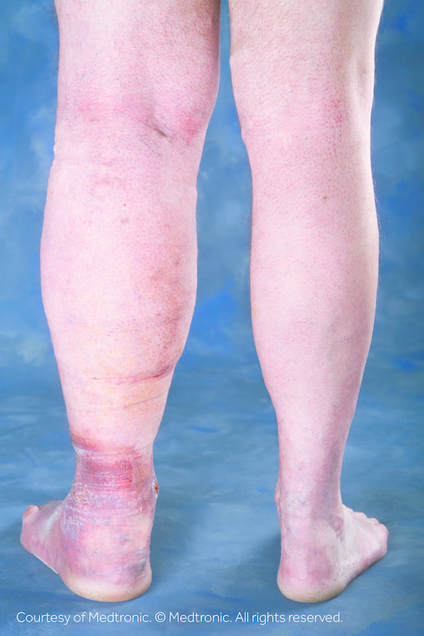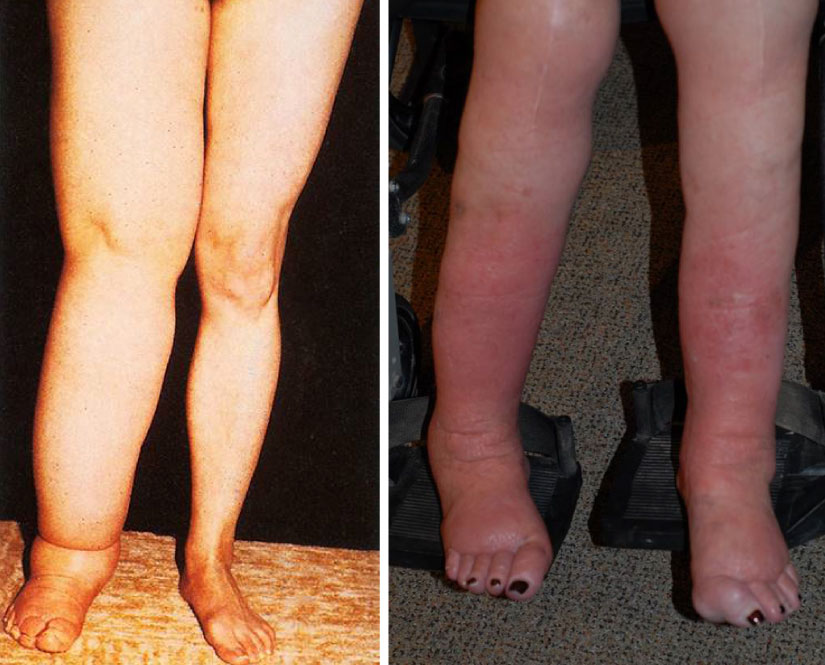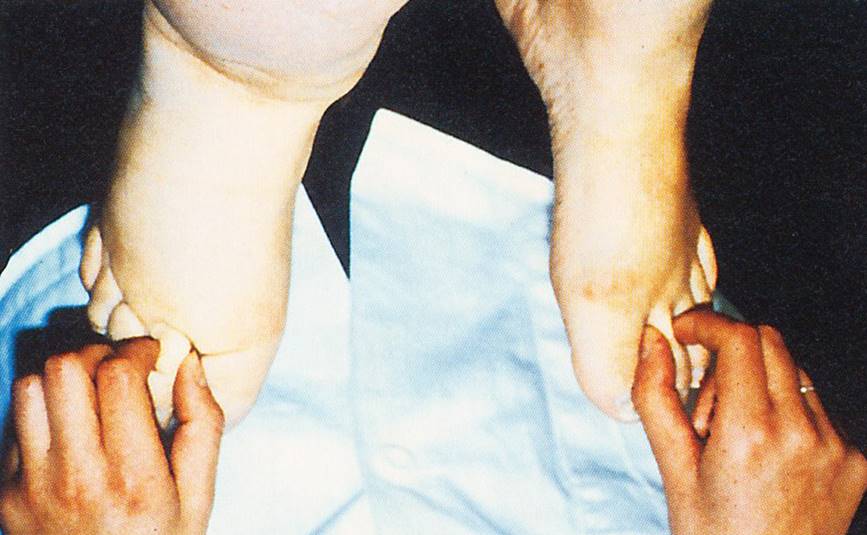|
Swelling can involve:
Swelling can be:
The most specific sign of venous disease is swelling in only one leg, or in both legs with one worse than the other. Systemic causes of edema such as right heart failure, fluid retention, a drug effect, or many other causes, produce swelling in both legs equally. Noting unequal swelling does not rule out these systemic causes. Although it is possible for venous or lymphatic disease to cause equal swelling in both legs these diseases usually produce unequal or one sided swelling. Deep venous thrombosis (DVT) is an acute problem that usually occurs in one extremity. The swelling and pain is usually more severe than in the chronic causes of edema. Chronic venous insufficiency (CVI) is, more often than not, unequal, although, because of its hereditary nature, incompetent valves in the superficial veins of both legs can produce equal swelling. Patients with CVI and swelling are classified as C2.
|
Lymphedema of the lower extremities is underappreciated. It can produce any of the patterns above and it is chronic. Lymphedema is caused by obstruction or interruption of the lymphatic channels, leading to impeded flow out of the extremities. It can be primary, occurring for no known reason, at any time of life.
Causes of secondary lymphedema include:
Unless there is an obvious cause of lymphedema, work-up should include a venous ultrasound to rule out CVI. In obese patients, fat cells can obstruct the lymphatics. Weight loss is often required for effective lymphedema therapy. In morbidly obese patients, gastric bypass is sometimes required. Lymphedema produces unique physical findings, including swelling of the top of the foot, deepened folds of skin over the ankle, and a positive Stemmer's sign, the inability to pinch the skin at the base of the second toe. With severe lymphedema, the skin can erode, producing a large quantity of thin, watery drainage, or lymphorrhea. This skin erosion does not resemble a venous ulcer. Unlike other types of swelling, lymphedema does not respond to diuretics. It is treated by decongestive therapy, consisting of manual lymphatic drainage (MLD), a specific massage technique used to relieve lymphatic obstruction, and compression. MLD is a very gentle technique, as lymphatics are just deep to the skin. Older patients can be taught to perform MLD since it is not physically demanding. Pneumatic compression pumps can also be very effective managing lymphedema. Bronze skin discoloration is easily distinguished from the skin changes of CVI. Redness of the skin associated with lymphedema is often confused with an infection. Unless there is fever, or other sign of infection, the red color in the skin is from inflammation of the lymphatics from chronic obstruction. The redness does not respond to antibiotics. These are all signs of lymphedema and they respond to decongestive therapy.
Thus, when a patient presents with unequal lower extremity swelling, unless there is a history of an injury, venous disease or lymphedema is usually the cause.
- Cancer with spread to the lymphatics
- Surgery interrupting lymphatics
- Chronic venous insufficiency
- Soft tissue infection that leads to scarring of the lymphatics
- Obesity
- Parasitic infection (filariasis)
Unless there is an obvious cause of lymphedema, work-up should include a venous ultrasound to rule out CVI. In obese patients, fat cells can obstruct the lymphatics. Weight loss is often required for effective lymphedema therapy. In morbidly obese patients, gastric bypass is sometimes required. Lymphedema produces unique physical findings, including swelling of the top of the foot, deepened folds of skin over the ankle, and a positive Stemmer's sign, the inability to pinch the skin at the base of the second toe. With severe lymphedema, the skin can erode, producing a large quantity of thin, watery drainage, or lymphorrhea. This skin erosion does not resemble a venous ulcer. Unlike other types of swelling, lymphedema does not respond to diuretics. It is treated by decongestive therapy, consisting of manual lymphatic drainage (MLD), a specific massage technique used to relieve lymphatic obstruction, and compression. MLD is a very gentle technique, as lymphatics are just deep to the skin. Older patients can be taught to perform MLD since it is not physically demanding. Pneumatic compression pumps can also be very effective managing lymphedema. Bronze skin discoloration is easily distinguished from the skin changes of CVI. Redness of the skin associated with lymphedema is often confused with an infection. Unless there is fever, or other sign of infection, the red color in the skin is from inflammation of the lymphatics from chronic obstruction. The redness does not respond to antibiotics. These are all signs of lymphedema and they respond to decongestive therapy.
Thus, when a patient presents with unequal lower extremity swelling, unless there is a history of an injury, venous disease or lymphedema is usually the cause.




